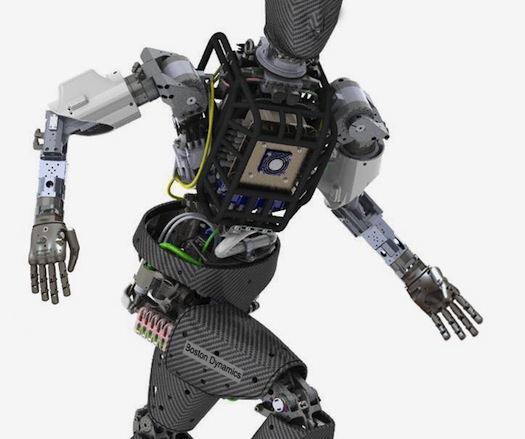


The DARPA Robotics Challenge (DRC), the most ambitious robot competition in history, cleared a key milestone yesterday. The Pentagon’s research wing announced the results of the Virtual Robotics Challenge, a five-day-long qualification event during which 26 teams from around the world directed a humanoid robot to complete astonishingly difficult tasks, with little to no human intervention, including picking up, attaching, and turning on a fire hose. Seven teams advanced, earning funding and the use of a government-provided robot, the 5-foot-10, 240-pound Boston Dynamics-built Atlas, in the next phase of the DRC.
The caveat, of course, is that the Virtual Robotics Challenge happened entirely within a simulation program. It was an audition, essentially, for the first physical trial this December, where the seven winning teams and their lineup of identical Atlas bots will join a more diverse menagerie of team-built robots. The highest-scorers among that group will compete in the final showdown, yet another multi-task obstacle course scheduled for December 2014, with a top prize of $2 million.

But as groundbreaking as the DRC could be for the entire field of robotics—and particularly for the prospect of bots than can navigate human environments and tools, possibly to save our lives—the virtual leg of the competition has already produced a tool of seismic potential. Gazebo, the simulation software that DARPA funded, provided to every DRC team, and used for this recent qualifier, is available right now. Its free to download for anyone (Linux/Ubuntu only, for now, though OSX and Windows versions are coming).
Cooler still, you can also download a fully detailed virtual model of Atlas, one of the most advanced humanoid robots on the planet, as well as the exact arena and challenges used in the recent event, which ran from June 17 to 21. Everything those teams had access to, and everything they had to overcome, from the dimensions and compliance of the seat those virtual Atlases had to scramble into, in order to drive a utility vehicle across the course, to the friction property of the robots’ hands as they gripped the steering wheel, is fully available.
Gazebo pre-dates the DRC, as what Open Source Robotics Foundation CTO Nate Koenig calls a side-project. It was similar to the kinds of simulators that individual robotics labs whip up for their own research, to model the environment a system might have to contend with, as well as the system itself. But according to Koenig, he was approached by DARPA last year to not only provide a simulator for use in the DRC, but to turn Gazebo into a simulator fit for the entire world. “They didn’t want to just pay for the simulator upfront, and then it goes away,” Koenig says. “We’ve already developed things for the simulator that are outside the scope of the DRC. Easily modeling buildings, robot GUI [graphical user interface], all funded by DARPA. They see this simulator as a game-changer in terms of making robotics accessible to everyone.”
This simulator is a game-changer that could make robotics accessible to everyone.DARPA supplied $6M in funding to the Open Source Robotics Foundation (OSRF) over a three-year period. It was enough for Koenig to assign 10 full-time programmers to overhaul and expand Gazebo. The simulation software has become exponentially more detailed over the past year, allowing users to model and determine everything from the performance of sensors to the failure point of joints under load. One of Gazebo’s best features: the control algorithms you set up within the simulator, or a virtual robot, can be instantly fed to its real-life counterpart (and vice versa). In other words, if you’ve determined how to make a robot climb a ladder in the program, you can plug that code into the physical system, and watch it go. And while OSRF’s involvement in the DRC is now effectively finished, Gazebo’s development will continue to be funded for the next year-and-a-half, refining existing features and adding new ones.
According to both DARPA and OSRF, the ultimate goal for Gazebo is to not only allow labs to compare results and share code, but to reduce the barrier-to-entry for robotics research and development. In that vein, Gazebo is specifically designed to work with cloud computing assets—off-site computers that are rented, in most cases, to handle the bulk of the simulator’s computation. While DARPA provided access to cloud assets to the Virtual Robotics Challenge teams, Koenig points out that equivalent resources can be rented from Amazon for a few dollars per hour, a vastly cheaper option than buying powerful computers outright. “Now that we have cloud simulation, the idea of making robotics low-cost enough for anyone—high-school teachers, small companies—that’s a reality.”

In fact, it’s entirely possible that Gazebo will be the only tangible product of the DRC. DARPA’s first robotic car race, the 2004 Grand Challenge, ended with an autonomous whimper, when none of the self-driven vehicles crossed the finish line in qualifying time. Follow-up Challenges proved more fruitful, but the DRC’s full roster of tasks (which include sawing through a wall with a cordless power tool) could be too difficult even for the world’s best robotics teams. But even in that worst-case scenario, DARPA and the DRC will have created a free, powerful tool, with the potential to unite an entire field.
